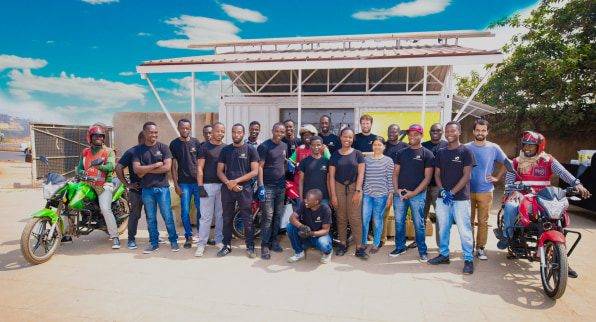There Are More Motorcycles In Kigali Than Cabs In New York & A Rwandan Startup Is Making The Whole Fleet Go Electric One Bike At A Time

In the Rwandan capital, Kigali, between 20,000 to 30,000 motorcycles taxis speed around at any given time. This means that there are even more motorcycles in Kigali than there are cabs in New York, and this is a city that is even 10-times larger than the seat of the President Paul Kagame-led government.
One Rwandan startup is on a mission to transform each and every one of those motorcycles in Kigali into electric vehicles that not only alleviate environmental concerns but also come as a much better economic option for commercial motorcyclists.
E-moto company, Ampersand, is about helping the country’s motorcycle fleet go electric one bike at a time, and the startup is doing this with a business model that is quite unique.
At the moment, Ampersand has 20 electric motorcycles in Kigali and the company is raising money to build 500 more this year as the Rwandan government steps up effort to make the country’s whole motorbike fleet go electric.

While President Kagame has done a decent job of lifting Rwanda out of the ugly genocide of 1994 and the aftershocks of that ethnoreligious pogrom, the country is actually still mired by wide-spread poverty. The average Rwandan lives on USD 1.73 per day and less than USD 700 per year.
As in many other countries in sub-Saharan Africa, motorcycle taxis offer both a source of employment for thousands and a mobility solution for thousands more in Rwanda. But the gas-fueled motorcycles are not exactly a profitable tool for the individuals who rely on it as a source of livelihood.
After spending around USD 5.00 on fuel and another USD 6.00 on leasing a bike, a typical driver, or “motar,” might only make around USD 1.80 a day.
Ampersand is hoping to change by building two-wheelers that are cheaper to procure and maintain. The new electric motorcycles, or e-motos, are designed to be cheaper than the gas alternative, particularly in terms of fuel, the driver’s biggest expense.
“The drivers here cover very large distances every day, so they burn a lot of fuel,” Josh Whale, Ampersand’s CEO, tells Fast Company. “After they’ve paid for this fuel and paid for their bike and other costs, it’s not much left at the end of the day.”
Because the new motorcycle is cheaper to charge than the old motorbikes are to fill with gas, the company estimates that drivers can save as much as USD 650.00 or USD 700.00 a year on fuel alone.
Now, that may not seem like a lot but USD 700.00, perhaps to the average American commuter. But in Rwanda, where many people make less than that amount in an entire year, saving USD 700.00 in fuel costs is a big deal.
Ampersand is offering riders the opportunity to either lease the electric motorcycles or purchase them upfront at no extra cost (less cost, actually, with the lease offer).
If drivers lease the new e-moto, the cost is around USD 2.00 less than a gas moto taxi; for drivers paying upfront, the cost is the same.
Drivers also pay for a maintenance plan that is designed to be more than USD 4.00 cheaper than what they currently spend each week on service and oil changes.
Ampersand builds the e-motos using off-the-shelf parts to keep costs low. The company also fabricates its own custom battery pack to optimise total costs.
Ampersand also has a rather interesting way of making sure riders never run out of juice. When the motorcycle needs more power, instead of charging the battery themselves, drivers pull into a small battery swap station.
It’s the stuff of pit-stops at a Formula One Grand Prix or motorcycle racing pit. Ampersand has built battery stations out of recycled shipping containers.
At those stations, there are always charged batteries on standby, as well as attendants who bring out a new battery and quickly make the switch, scanning the old battery to measure how much power is left.

Drivers only get to pay for the amount they’ve used, in a model comparable to buying gas. The entire process takes all of two minutes.
Besides money savings, the e-motos are easily more powerful than the gas motorcycles currently in use. The vehicles are also more comfortable to ride on long shifts with automatic shifting and less vibration and noise. In Rwanda, drivers often work 12 to 13 hours a day and the new e-motos are much strenuous to ride.
The noiselessness of the e-motos does present a traffic hazard, and that’s why Ampersand has added cheap electric speakers that double as a kind of stereo system.
Ampersand launched in May 2019 and after starting out with a small number of riders, the company’s e-motos were soon on every one’s lips. This saw the waiting list grow to up to 1,300 people before long.
In August 2019, Rwanda’s president announced that the government planned to transition the entire country to electric motorcycles, and the waiting grew more than five-fold to 7,000 people.
Rwanda, just like most other East African countries, has an electric grid that produces a surplus of power, though the country spends more on fuel imports than anything else.
And Ampersand is looking to put some of that surplus power to good use while simultaneously cutting down on the need for fuel.
The Rwandan government, though still developing a plan for the transition to electric vehicles, has already tasked Ampersand to build 5,000 e-motos.
The startup also has its eyes on neighbouring East African markets like Kenya and Uganda where motorcycle taxis also find heavy use in a sub-regional industry estimated to be raking in USD 14 Bn annually.